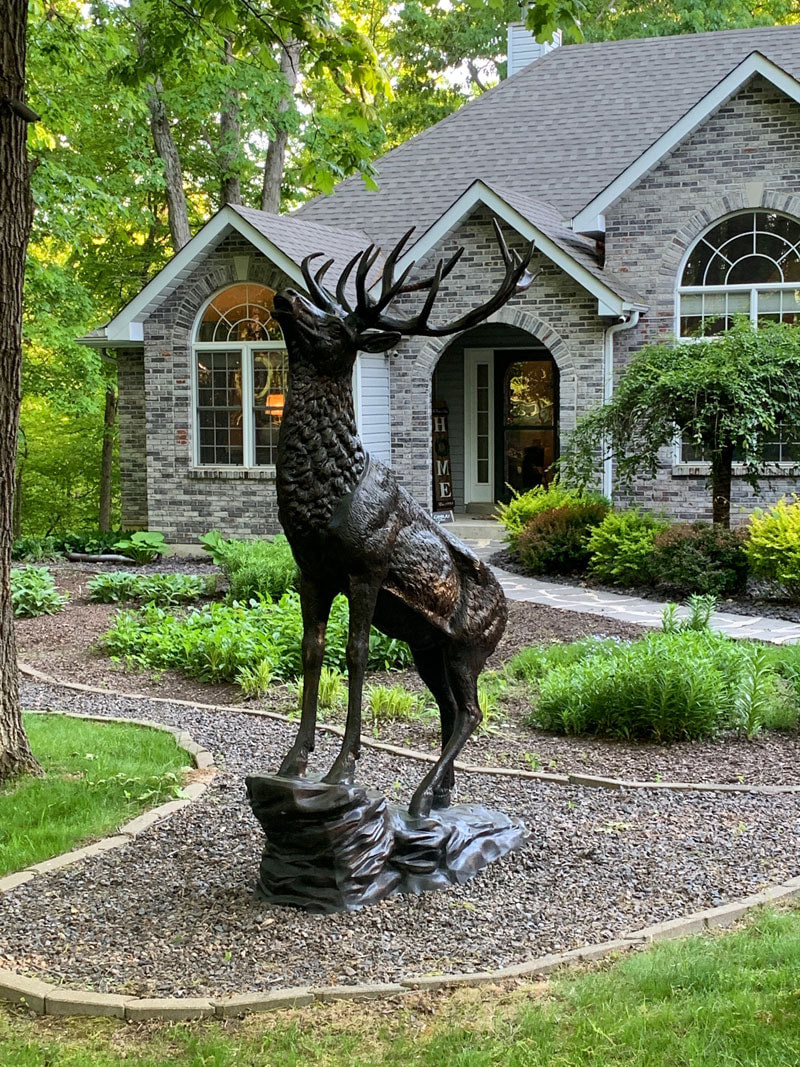
What Does the Elk Sculpture Mean
In the quiet heart of a mountain town nestled beside pine-covered ridges and winding rivers, an elk sculpture stands tall at the edge of the town square. Cast in bronze, its antlers stretch toward the sky, majestic and proud. It is not just a piece of art; it is a sentinel of the past, a guardian of the wilderness, and a storyteller in stillness.
To many, it may seem like just a beautiful statue, a decorative touch to an otherwise rustic town. But for those who stop and truly look, the elk sculpture offers a deep, symbolic journey through history, nature, culture, and spirit. It speaks of resilience, strength, leadership, and the quiet nobility of the wild. It’s more than an object, it’s a bridge between humanity and the natural world.
The Elk: More Than an Animal
To understand the elk sculpture, one must first understand the elk itself.
Elk, also known as wapiti, a Native American word meaning “white rump”, are among the largest species of the deer family. Native to North America and parts of Asia, these creatures have long been revered by indigenous peoples, frontiersmen, and modern wildlife enthusiasts alike. Their presence in forests and meadows is a symbol of the health of the land. When you see elk, it means the ecosystem is thriving.
They are known for their strength, grace, and the haunting beauty of their calls, those long, echoing bugles that rise in early morning mist during mating season. They are powerful, yet peaceful; wild, yet balanced. It is this paradox of gentleness and might that has made the elk a powerful symbol across cultures.
What Does the Elk Sculpture Mean
At a glance, an elk sculpture may simply appear decorative. But its meaning runs far deeper.
1. Strength and Nobility
The elk, with its towering antlers and firm posture, represents strength and nobility. An elk sculpture often portrays the animal in a commanding stance, chest forward, eyes alert, antlers raised high. This image evokes admiration and respect. In many cultures, the elk is considered a noble creature, a kind of forest king. A sculpture captures this aura, turning it into a permanent tribute to these traits.
2. Endurance and Resilience
Elk are migratory animals, traveling great distances through rugged terrain to find food and shelter. Their resilience in the face of harsh winters and challenging landscapes is legendary. An elk sculpture may symbolize endurance and the spirit to keep going no matter the conditions. It’s a reminder that we, too, can navigate life’s challenges with grace and determination.
3. Connection to Nature
An elk is a creature of the wild, living in harmony with the seasons. It symbolizes a deep connection to nature and a balanced existence. For those who feel drawn to natural living or the preservation of wildlife, an elk sculpture becomes more than art, it becomes a declaration of values. It speaks of respect for the Earth and all its inhabitants.
What Does the Elk Monument Symbolize?
When we talk about elk monuments, especially large public statues or memorials, the symbolism becomes even richer. These aren’t just decorative pieces; they are intended as cultural markers, tributes, or even memorials.
1. Tribute to Wildlife and Conservation
Many elk monuments are installed in national parks or natural reserves. They serve as reminders of the importance of conservation and the role of elk in local ecosystems. They may honor efforts to reintroduce elk to areas where they had vanished or to protect their habitats from human encroachment.
For example, in Yellowstone National Park, elk are a key species. An elk monument near such a site may stand as a tribute to the balance of ecosystems and the efforts to preserve wild lands for future generations.
2. Honor to Hunters and Indigenous Traditions
Elk have long been revered in Native American cultures. Tribes such as the Lakota, Nez Perce, and Blackfeet viewed elk as spiritual guides and sources of sustenance. Elk antlers were used in ceremonies, and elk hides were crafted into clothing and tools.
A monument in such a context might symbolize the spiritual and practical relationship between humans and elk, honoring traditions of respect and balance in hunting.
Similarly, elk also represent a cultural legacy for hunting communities. An elk monument may stand as a memorial to hunters who followed ethical, respectful practices, serving as a reminder that hunting can be about more than sport, it can be about stewardship and understanding.
3. Community Identity
In mountain towns across North America, from Colorado to British Columbia, elk are part of local identity. Annual elk migrations bring both tourists and locals together to witness nature’s spectacle. A large elk monument may be erected in the town center to reflect community pride and a shared bond with the surrounding wilderness.
The elk becomes a cultural icon, and the sculpture is the tangible embodiment of that identity.
What Does the Elk Sculpture Represent in Art?
Beyond the cultural and natural symbolism, the elk holds deep spiritual meanings, particularly in art, mythology, and spiritual traditions.
1. The Divine Masculine and Feminine
In spiritual symbolism, elk often represent the sacred masculine, strong, protective, and grounded. Their antlers, which grow and shed annually, are seen as symbols of regeneration and the life cycle. In contrast, female elk (cows) symbolize nurturing, protection, and the sacred feminine.
A sculpture that includes both male and female elk, perhaps a stag and a cow standing together, might represent balance between masculine and feminine energies, harmony in relationships, or the unity of opposites.
2. Guidance and Transformation
Elk are migrators, often traversing great distances in search of food. Spiritually, this movement can represent a soul journey or a life path. Seeing or honoring an elk sculpture can be symbolic of personal transformation, movement forward, and the journey toward one’s true self.
In Native American dream interpretation, elk appearing in dreams, or in symbolic forms like sculptures, can signify a guide is nearby, or that it’s time to embark on a journey, either physical or spiritual.
3. Leadership and Community
Elk live in herds and exhibit clear social structures. The mature bull leads during mating season, but the herd operates cooperatively. In this way, elk represent leadership balanced with cooperation, a model for healthy communities. A sculpture of a lone elk may emphasize individual strength, while a group of elk in sculpture might signify unity, community, and collective wisdom.
Is Elk Sculpture Good for Garden Sculpture?
Absolutely, and not just for aesthetic reasons.
1. Aesthetic Appeal
Elk sculptures are visually stunning. With their large, sweeping antlers, muscular build, and poised posture, they make a striking focal point in any garden. Whether crafted in bronze, resin, stone, or wood, they add a touch of wilderness majesty to a natural space.
Placed among trees, rocks, or near water features, elk sculptures blend beautifully with outdoor elements, creating a sense of harmony with nature.
2. Symbolic Environment
Placing an elk sculpture in your garden can transform your space from simply “outdoors” to something more meaningful. It creates an atmosphere of peace, strength, and wild elegance. For those who meditate or practice mindfulness, an elk sculpture can serve as a visual anchor, reminding you to be grounded, graceful, and strong.
3. Feng Shui and Energy Flow
In Feng Shui, elk are associated with noble pursuits, career success, and longevity. Positioning an elk sculpture in your garden, particularly facing outward toward an open area, is believed to attract prosperity, opportunities, and protection.
It becomes a guardian of your space, especially when placed near the entrance or at the edge of a property.
4. Conversation Starter and Educational Tool
For families or nature lovers, an elk sculpture can also serve an educational role. It invites curiosity from guests, encourages children to ask questions about wildlife, and opens the door to discussions about conservation, ecology, and cultural heritage.
It’s a sculpture, but it’s also a story, one you get to tell.
Types of Elk Sculptures for Gardens
There are many styles to choose from, depending on your space and taste:
Bronze Elk Sculptures: Elegant, durable, and timeless. These often become the centerpiece of gardens and are designed to weather beautifully.
Resin or Fiberglass Elk Statues: Lightweight and more affordable, ideal for home gardens with changing layouts.
Wood Carved Elk: Rustic and artistic, often made from reclaimed wood or logs. These are great for cabins and forested areas.
Modern/Abstract Elk Sculptures: For contemporary gardens, stylized elk in metal or stone can add a unique flair.
The Living Spirit in Bronze and Stone
An elk sculpture is never just an ornament. It is a tribute to a powerful and graceful creature. It is a symbol of strength, endurance, balance, and spiritual journey. Whether standing proudly in a town square or quietly watching over a backyard garden, the elk sculpture connects us to something older, wilder, and wiser.
In a world that moves fast, the elk reminds us to stand tall, move with purpose, and live with quiet dignity. When you invite an elk sculpture into your space, whether it be public or private, you’re not just adding beauty. You’re honoring a legacy.
The elk’s spirit lives in stillness and in motion, in the wild and in art. And through sculpture, we give that spirit a place to rest, and to inspire. image/aluminumyardart.com




